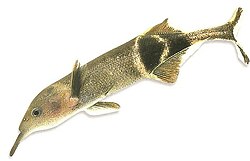| Mormyroidea | |
|---|---|
 | |
| Elephantnose fish | |
| Scientific classification | |
| Kingdom: | Animalia |
| Phylum: | Chordata |
| Class: | Actinopterygii |
| Order: | Osteoglossiformes |
| Superfamily: | Mormyroidea |
The Mormyroidea (synonymy: Mormyriformes) are a superfamily (formerly an order) of fresh water fishes endemic to Africa that, together with the families Hiodontidae, Osteoglossidae, Pantodontidae and Notopteridae , represents one of the main groups of living Osteoglossiformes. [1] They stand out for their use of weak electric fields, which they use to orient themselves, reproduce, feed, and communicate. [2] [3]
Contents
- Etymology
- Distribution and ecology
- Ecology
- Distribution
- Morphology
- Sizes and shapes
- Brain and cerebellum
- Electric organs
- Behavior
- Communication
- Feeding
- Reproduction
- Classification
- Family Gymnarchidae (Bleeker, 1859)
- Family Mormyridae (Bonaparte, 1832)
- Phylogeny
- Threats and protection
- Notes
- References
There is no consensus regarding its superior biological classification as some experts state that it belongs to the suborder Osteoglossoidei , while others to the Notopteroidei . In either case, the mormyriformes include the gymnarchids and mormyrids [4] and represent the largest superfamily within the order Osteoglossiformes with about two hundred and thirty-three subordinate taxa [5] that are distributed across various watersheds existing throughout tropical Africa south of the Sahara, including the Nile, [6] Turkana, Gambia, and northern South Africa. [7] [8] [9]
These fish have a large brain and an unusual intelligence, [10] they feed on benthic and allochthonous invertebrates, as well as some crustaceans found in marshy and sandy areas of rivers and lakes. [11] Most of its species are sociable, and although their reproductive form is little known, they generally reproduce during the rainy season and their electrical organs transmit signals with the capacity to influence their reproductive and hormonal behavior. [12] [13]
According to the International Union for Conservation of Nature (IUCN), the conservation status of 66.7% of the species is Least Concern and 10.8% is Threatened species. [14] Furthermore, according to the same institution, the extinction rate of the taxon – at least in the northern region of the African continent – reaches 44.4%, while 55.6% of the individuals are threatened. [15]





